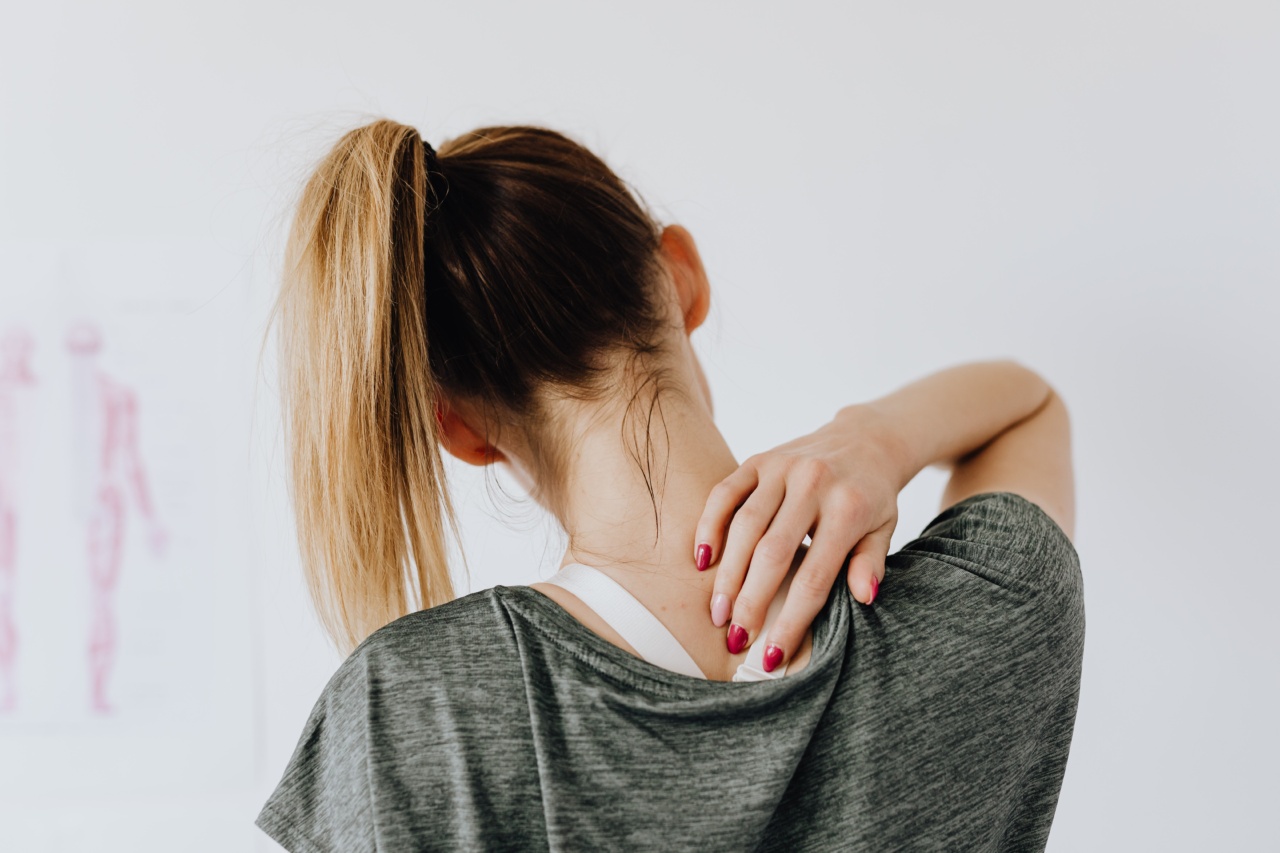Middle back pain refers to any discomfort or pain felt in the region between the upper and lower parts of the back, known as the thoracic spine. This area is located between the base of the neck (cervical spine) and the lower back (lumbar spine).
Middle back pain is less common than neck or lower back pain but can still be a cause of great discomfort. Understanding the causes, symptoms, and remedies for middle back pain is crucial in effectively managing and treating the condition.
Causes of Middle Back Pain
Several factors can contribute to middle back pain. Some common causes include:.
1. Poor Posture
Sitting or standing with a slouched or hunched posture can strain the muscles and ligaments in the middle back, leading to pain. It is important to maintain good posture while sitting, standing, and lifting heavy objects to prevent middle back pain.
2. Muscle Strain
Overexertion, sudden movements, or lifting heavy objects incorrectly can strain the muscles in the middle back, resulting in pain and discomfort. Muscle strains can also occur due to repetitive movements or chronic overuse of the back muscles.
3. Injury or Trauma
Middle back pain can be caused by direct injury or trauma, such as a car accident, fall, or sports-related impact. These injuries can lead to sprains, fractures, or disc herniation, causing middle back pain.
4. Poor Ergonomics
Using improper ergonomics in the workplace, such as poorly designed chairs or desks, can lead to middle back pain. Prolonged sitting in a poorly supported position can strain the muscles and put pressure on the spinal discs, causing pain.
5. Herniated Disc
A herniated disc occurs when the outer shell of a spinal disc ruptures, causing the inner gel-like material to leak out. If this happens in the thoracic region, it can lead to middle back pain.
Herniated discs can occur due to age-related degeneration or injury.
6. Osteoarthritis
Osteoarthritis is a degenerative joint disease that can affect any joint in the body, including the spine. When the joints in the thoracic spine become inflamed and damaged, it can result in middle back pain.
7. Scoliosis
Scoliosis is a condition characterized by an abnormal curvature of the spine. If the curvature affects the thoracic spine, it can cause middle back pain. Scoliosis can be congenital or develop during adolescence.
8. Stress and Anxiety
Emotional stress and anxiety can manifest physically in the body, including tension and muscle tightness in the middle back. Persistent stress can lead to chronic middle back pain.
9. Postural Abnormalities
Certain postural abnormalities, such as kyphosis (excessive rounding of the upper back) or lordosis (excessive inward curvature of the lower back), can put strain on the middle back, leading to pain and discomfort.
10. Medical Conditions
Certain medical conditions, such as fibromyalgia, spinal stenosis, or thoracic outlet syndrome, can cause middle back pain as a symptom. These conditions require medical diagnosis and treatment for effective pain management.
Symptoms of Middle Back Pain
The symptoms of middle back pain can vary depending on the underlying cause. Common symptoms include:.
1. Dull Aching Pain
Middle back pain is often characterized by a dull, aching sensation in the thoracic region. The pain may be intermittent or constant and can vary in intensity.
2. Muscle Stiffness
People with middle back pain may experience muscle stiffness or tightness in the affected area. This can limit mobility and make it challenging to perform everyday tasks.
3. Limited Range of Motion
Middle back pain can restrict the range of motion in the upper body. Activities that involve bending, twisting, or reaching may be difficult and painful.
4. Radiating Pain
In some cases, middle back pain can radiate to other areas of the body, such as the shoulders, arms, or chest. This can be a sign of nerve irritation or compression.
5. Muscle Spasms
Muscle spasms, involuntary contractions of the back muscles, can accompany middle back pain. These spasms can cause sudden and sharp pain.
6. Numbness or Tingling
Numbness or tingling sensations in the middle back or other areas of the body can occur when there is nerve involvement. This may be a sign of a more serious underlying condition.
7. Difficulty Breathing
In rare cases, middle back pain can be associated with difficulty breathing. If this occurs, it is essential to seek immediate medical attention, as it may indicate a severe medical condition.
Remedies for Middle Back Pain
There are various remedies and treatment options available to alleviate and manage middle back pain. These include:.
1. Pain Medication
Over-the-counter nonsteroidal anti-inflammatory drugs (NSAIDs), such as ibuprofen or naproxen, can help reduce pain and inflammation associated with middle back pain.
However, it is essential to follow the recommended dosage and consult a healthcare professional if the pain persists or worsens.
2. Hot and Cold Therapy
Applying a heating pad or hot water bottle to the affected area can help relax muscles and increase blood flow. Alternatively, using an ice pack or cold compress can reduce inflammation and numb the area.
Both hot and cold therapy can provide temporary relief from middle back pain.
3. Physical Therapy
A physical therapist can guide individuals through exercises and stretches specifically designed to strengthen the back muscles, improve posture, and increase flexibility.
Physical therapy can help alleviate middle back pain and prevent future episodes.
4. Corrective Posture Techniques
Learning and practicing correct posture techniques can greatly reduce middle back pain caused by poor posture. This includes sitting and standing up straight, maintaining a neutral spine, and using ergonomic equipment.
5. Relaxation Techniques
Practicing relaxation techniques, such as deep breathing exercises, meditation, or yoga, can help reduce stress and tension in the muscles, providing relief from middle back pain.
These techniques can promote overall well-being and improve the body’s response to pain.
6. Massage Therapy
Massaging the middle back area can help relax tight muscles and improve circulation. It is advisable to seek a professional massage therapist who specializes in treating back pain to ensure proper technique and safety.
7. Lifestyle Modifications
Making certain lifestyle modifications can contribute to relieving middle back pain. This may include regular exercise, maintaining a healthy weight, avoiding prolonged sitting or standing, and using proper body mechanics when lifting heavy objects.
8. Injections or Medications
In certain cases, a healthcare professional may recommend injections, such as epidural steroid injections, to reduce inflammation and relieve middle back pain. They may also prescribe muscle relaxants or other medications to manage pain and discomfort.
9. Supportive Devices
Using supportive devices, such as back braces or ergonomic pillows, can help maintain proper spinal alignment and reduce strain on the middle back. These devices can provide additional support during daily activities and promote healing.
10. Surgery
In severe cases where conservative treatments have been unsuccessful, surgery may be considered.
Surgical options for middle back pain depend on the specific underlying condition and may involve removing a herniated disc, spinal fusion, or other procedures recommended by a qualified surgeon.




























